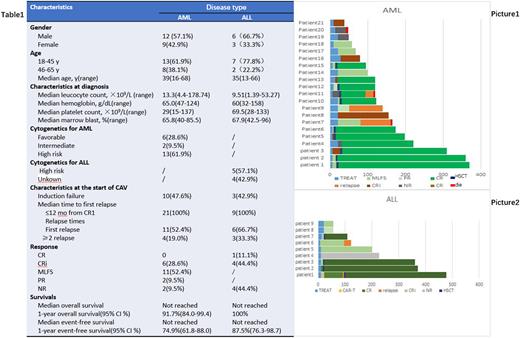Abstract
Background: Patients with relapse/refractory acute leukemia often show resistance to conventional chemotherapy and have dismal prognosis. Salvage therapy using venetoclax combined with hypomethylating agents achieved an overall response rate of approximately 40% in relapsed/refractory (R/R) acute myeloid leukemia (AML) patients. Cladribine is an adenosine deaminase resistant analog of adenosine. The efficacy of cladribine and venetoclax in R/R acute leukemia (AL) has not been reported. Here, we report preliminary results of venetoclax, cladribine plus low-dose cytarabine (CAV regimen) in the treatment of R/R AL. This study was registered at ClinicalTrials.gov (NCT05190549).
Methods: 30 patients were enrolled from March 2021 to May 2022 at the First Affiliated Hospital of Soochow University. 21 patients were diagnosed with R/R AML (6 patients with favorable risk, 2 patients of intermediate risk and 13 patients with high risk at diagnosis) (Table 1). Seven patients were diagnosed with R/R Philadelphia chromosome-negative B-cell acute lymphoblastic leukemia (ALL) (5 with high risk and 4 patients of unknown). The CAV regimen consisted of cladribine 5 mg/m2/day from day 1 to day 3 or day 5, cytarabine 20mg/m2, q12h for 7-10 days, venetoclax 100mg d1, 200 d2, 400 mg/day from day 3 to day 28 (The exact number of days is at the investigator's decision). Bone marrow evaluation were performed within 1 week at the end of treatment.
Results: The median age of enrolled patients were 39 in AML and 35 in ALL. 13/21 (66.9%) of AML patients and 5/9 (51.6%) of ALL patients had high-risk cytogenetics at diagnosis. All patients showed early relapse (less than 12-months from CR1). After one cycle of the CAV regimen, the overall response rate (ORR=CR+CRi+MLFS+PR) for AML was 90.5%. The rate of CR/CRi/MLFS was 81% in AML and CR/CRi was 55.6% in ALL. The estimated 1-year overall survival (OS) in AML and ALL was 91.7% and 100%, respectively. The event-free survival (EFS) for AML and ALL were 74.9% and 87.5%, respectively. The median OS, EFS of one year for all 30 patients were not reached. There was no significant statistical difference of disease type in OS (P=0.162) and EFS (P=0.935). During the treatment with CAV regimen, 7 patients (33.3%) developed grade 1 to 2 elevated transaminases. 5 patients (23.8%) developed grade 1 to 2 nausea and vomiting and 1 patient(7.4%) developed grade 3 nausea and vomiting. 3 patients(14.3%) developed grade 1 to 2 skin pruritus and rash. During a median follow-up of 116-days, 3 patients died of disease relapse(Picture1,2). There was no CAV treatment-related mortality.
Conclusion: The CAV regimen was an effective and safe salvage strategy in relapse/ refractory acute leukemia.
Disclosures
No relevant conflicts of interest to declare.
Author notes
Asterisk with author names denotes non-ASH members.


This feature is available to Subscribers Only
Sign In or Create an Account Close Modal